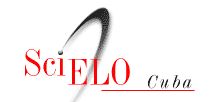El consumo de sal ¿Riesgo o necesidad?
Resumen
Se realizó una revisión acerca del consumo de sal y sus usos en las diferentes etapas de la historia de la humanidad. Se abordan elementos relacionados con su presencia en el organismo, las funciones fisiológicas esenciales para el mantenimiento homeostático en la vida, así como las complicaciones cuando sus niveles son inferiores a los límites fisiológicos, o superiores a estos. Se analizaron diferentes estudios y sus contradicciones sobre los daños que ocasiona a la salud el consumo de sal. Se precisan los grupos poblacionales sal sensibles (SS) y sal resistentes (SR), pautados por estudios realizados, así como las posibles causas de sus variaciones. Se emiten conclusiones en cuanto a riesgo y beneficio del consumo de sal. Se recomienda intervenir en un equilibrado consumo, tanto para los individuos como para las poblaciones.
Palabras clave
Referencias
a. Kurlansky M.Salt: A World History.UK:Penguin Books;2003.
Flad R, Zhu J, Wang C, Chen P, Von Falkenhausen L, Sun Z et al.Archaeological and chemical evidence for early salt production in China.PNAS.2005; 102(35):12618-22.
Wilson T, Grim CE.Sodium. En: Kiple KF, Coneè Ornelas K (ed.). The Cambridge World History of Food.UK :Cambridge University Press;2000.
McKillop HI.Salt: White Gold of the Ancient Maya.Gainesville:University Press of Florida;2002.
De la Hunty A.The COMA report on nutritional aspects of cardiovascular disease: the scientific evidence.British Food Journal.1995; 97(9):30-2.
Plata Montero A.El ciclo productivo de la sal y las salinas reales a mediados del siglo XIX.España:Diputación Foral Álava;2006.
Brown IJ, Tzoulaki I, Candeias V, Elliott P.Salt intakes around the world: Implications for public health.Int J Epidemiol.2009; 38(3):791-813.
Kostick DS. Salt.In: United States Department of the Interior, United States Geological Survey. 2006 Minerals Yearbook [Monografía en Internet].Reston, Virginia:USGS;2008.[citado 15 Oct 2011]Disponible en: http://minerals.usgs.gov/minerals/pubs/commodity/salt/myb1-2006-salt.pdf.
Dunlop J, Zronik JP.Salt.London:Crabtree Publishing Company;2004.
Burton R, Post T.Regulation of the effective circulating volume. In: Burton R. Clinical physiology of acid-base and electrolyte disorders. 5th ed.New York:McGraw-Hill;2000.
World Health Organization (WHO).Reducing Salt Intake in Populations: Report of a WHO Forum and Technical Meeting 5-7 October 2006, Paris, France [Internet].Geneva:WHO;2007.[citado 15 Oct 2011]Disponible en: http://www.who.int/dietphysicalactivity/reducingsaltintake_EN.pdf.
Bibbins-Domingo K, Chertow GM, Coxson PG, Moran A, Lightwood JM, Plecher MJ, et al.Projected effect of dietary salt reductions on future cardiovascular disease.N Engl J Med.2010; 362(7):590-9.
Asociación Médica Mundial.Declaración de la AMM sobre la Disminución del Consumo de Sal en la Alimentación [Internet].Francia:AMM;2008.[citado 20 Oct 2008]Disponible en: http://www.wma.net/es/30publications/10policies/s20/.
Organización Panamericana de la Salud.Estrategia para reducir el consumo de sal. Informe Reunión Bienal de CARMEN. Lima, Perú. 26-29 de octubre de 2009 [Internet].Perú:OPS;2009.[citado 20 Oct 2008]Disponible en: http://www.bvsde.paho.org/texcom/sct/047997.pdf.
Intersalt Cooperative Research Group.Intersalt: An international study of electrolyte excretion and blood pressure: Results for 24 hour urinary sodium and potassium excretion.BMJ.1988; 297(6655):319-28.
Sacks FM, Svetkey LP, Vollmer WM, Apple LJ, Bray GA, Harsha D, et al.Effects of dietary patterns on blood pressure and the Dietary approaches to Stop Hypertension (DASH) Diet.N Eng J Med.2001; 344(1):3-10.
Effects of weight loss and sodium reduction intervention on blood pressure and hypertension incidence in overweight people with high – normal blood pressure.The trials of Hypertension Prevention, phase III. The trials of Hypertension prevention Collaborative Research Group.Arch Intern Med.1997; 157(6):657-67.
Geleijnse JM, Grobbee DE, Kok FJ.Impact of dietary and lifestyle factors on the prevalence of hypertension in Western populations.J Hum Hypertens.2005; 19 Suppl 3:S1-4.
Asaria P, Chisholm D, Mathers C, Ezzati M, Beaglehole R.Chronic disease prevention health effects and financial costs of strategies to reduce salt intake and control tobacco use.Lancet.2007; 370(9604):2044-53.
Geleijnse JM, Kok FJ, Grobbee DE.Blood pressure response to changes in sodium and potassium intake: a metaregression analysis of randomised trials.J Human Hypertens.2003; 17(7):471-80.
Karppanen H, Mervaala E.Sodium intake and hypertension.Prog Cardiovasc Dis.2006; 49(2):59-75.
Coca A.Hipertensión esencial, sensibilidad a la sal y riesgo cardiovascular.Nefrología [Revista en Internet].2004[citado 25 Oct 2011]; 24(1):[aprox. 2p].Disponible en: http://www.revistanefrologia.com/revistas/P7-E232/P7-E232-S132-A2969.pdf.
Hall EJ, Guyton AT, Brands MW.Pressure-volume regulation in Hypertension.Kidney Int Suppl.1996; 55:S35-41.
Weinberger MH.Salt Sensitivity of Blood Pressure in Humans.Hypertension.1996; 27(Pt 3 2):481-90.
National Centre for Social Research.An assessment of dietary sodium levels among adults (aged 19-64) in the UK general population in 2008, based on analysis of dietary sodium in 24 hour urine samples [Internet].UK:National Center for Research;2008.[citado 25 Mar 2010]Disponible en: http://www.food.gov.uk/multimedia/pdfs/sodiumreport08.pdf.
Cubeddu LX, Alfieri AB, Hoffman IS, Jiménez E, Roa CM, Cubeddu R, et al.Nitric Oxide and salt sensitivity.Am J Hypertens.2000; 13(9):973-9.
Bibbins-Domingo K, Chertow GM, Coxson PG, Moran A, Lightwood JM, Plecher MJ, et al.Projected effect of dietary salt reductions on future cardiovascular disease.N Engl J Med.2010; 362(7):590-9.
Stakeholder and Expert Perspectives on Dietary Sodium Reduction in Canada: Input to the Multi-stakeholder Working Group on Sodium Reduction [Internet].Ottawa:Health Canada;2009.[citado 25 Mar 2010]Disponible en: http://www.hc-sc.gc.ca/fn-an/alt_formats/pdf/pubs/nutrition/sodium/2009-reduction-eng.pdf.
Enlaces refback
- No hay ningún enlace refback.
FINLAY EN: 








FINLAY CERTIFICADA POR:

Esta revista "no aplica" cargos por publicación en ninguna etapa del proceso editorial.
Dirección postal: Calle 51A y Avenida 5 de Septiembre Cienfuegos, Cuba Código postal: 55100.
http://www.revfinlay.sld.cu
Telefono: +53 43 516602. Telefax: +53 43 517733.
amgiraldoni@infomed.sld.cu
ISSN: 2221-2434
RNPS: 5129






